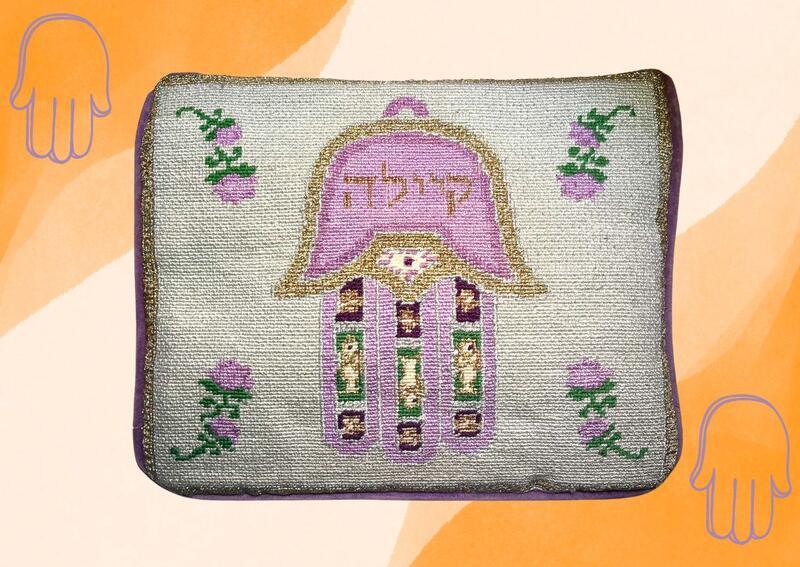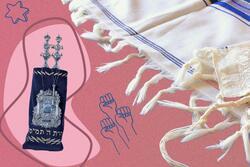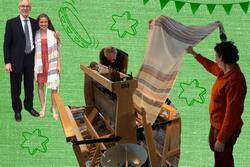Stitching My Tallit Bag, Stitching My Identity
Over the past nine years, my mom has made twelve tallit bags. Each design is as unique as its owner, each stitch is placed with a careful intention, and each bag carries its own meaning, its own interpretation of what it means to be Jewish. For me, my tallit bag is a constant reminder of what it means to be an unapologetically Jewish and fearlessly feminist woman.
The first tallit bag my mom ever made was for my eldest cousin, Andrew, who was the first in my generation to become a bar mitzvah. In the months leading up to the ceremony, she would spend hours pulling vibrant threads through miniscule color-coded holes in the stiff open weave canvas. Each rotation of the needle and each snip of the string became deeply ritualized, and I would stare at her nimble fingers dancing across the canvas until before I knew it, an entire row of needlepoint stitches had been completed.
Between having a full-time job and being a single mom to two kids, my mother’s free time is meager at best. But she finds time to work on the tallit bags wherever she can: on the couch as we watch movies, on the bleachers at my field hockey games, or even in the middle seat on a fully-booked plane. Her commitment to making each tallit bag with love and purpose has sparked a new meaning for me of doing Mitzvot, or the doing of good deeds.
To my mother, Judaism cannot exist without a sense of family. This is why she first began making tallit bags. The months of work she puts into each bag are for more than just a personalized gift – with each step of her ritual, she is creating a family heirloom that aims to represent each family member’s distinctive connection to Judaism.
In reflecting on identities of my family members, my unique place in the diaspora, which is the convergence of my Judaism, my feminism, and my Latinx culture, immediately comes to mind.
Not many people in the United States are aware of the richness of the culture of Latinx Jews. My paternal great-grandparents, along with tens of thousands of other Jews, emigrated to Argentina from Eastern Europe just a few years before the Second World War. Their families continued to practice Judaism, establishing synagogues across the country, where new traditions prospered. When my dad immigrated to the United States, he brought with him some of those traditions, like salting our challah on Shabbat, and mixing Yiddish words into our Spanish. Now, my Abu (short for abuela) is one of the only Jewish people that remain in my dad’s childhood town of San Cristóbal, in Argentina’s Santa Fe province. But she has never strayed far from her Jewish identity, from traveling hundreds of miles to celebrate the High Holidays alongside family, to sharing with us kosher-for-Passover dishes from her childhood.
Four years ago, at age twelve, I chose the design that would eventually become made into my tallit bag. I spent days brainstorming a design that would perfectly encapsulate my complex Jewish identity. With my Abu and my mom in mind, I chose a design for my tallit bag that represents the influence that women have had throughout my life as a proud Jew.
On the face of my tallit bag, sits a large lavender hamsa, or Hand of Miriam, a traditional hand-shaped amulet that is meant to ward off evil spirits and negative energy. I first came across this symbol in my Abu’s house, as a hanging wooden hand marked with curved Hebrew script. After both speaking with Abu and conducting my own research, I learned the beautifully complex history of the hamsa, including its deep roots in cultures around the globe. In Latin America, the hamsa is better known as the figga, or fico, and is often worn by children as an amulet that wards off the evil eye.
To me, the hamsa is a manifestation of divine feminine energy. The prophetess Miriam, for whom the hamsa is named, makes many appearances in the Torah and other Jewish religious texts, especially in contexts that display her femininity and strength. The most vivid example of her womanhood is found in Exodus 15:20-21, in which she leads the Hebrew women in song and dance after the Israelites cross through the Red Sea. In a religion in which normative gender roles are common (for instance, in the Torah, Miriam is initially introduced as Moses’ unnamed sister), holding space for powerful women like Miriam is vital to my Jewish feminist identity.
My tallit bag was by my side during my b’nai mitzvah; propped up on the bimah as I read from the Torah. It sits next to my brother’s tallit bag during services, but I often take it out of its spot in the pew’s book rack. I run my finger along the stitches that form the hamsa, and the sparkly letters that spell out my Hebrew name, Kayla (קיילה). As I do this, I think of my mom carefully laying down each stitch. My identity is (literally) woven through my tallit bag. My mom’s dedication to each tallit bag represents the commitment to Judaism that she’s raised me with. She has been my most constant source of Jewish feminism, encouraging me to embrace each and every aspect of my identity.
Nowadays, my tallit bag remains neatly tucked away in one of my drawers. My family doesn’t frequent our synagogue like we once did, so I don’t get much use out of my tallit bag. But each time I take it out of its drawer and watch the silvery thread catch slivers of light, I think of my mom, my Abu, and the countless unashamedly Jewish women who have come before me.
This piece was written as part of JWA’s Rising Voices Fellowship.







